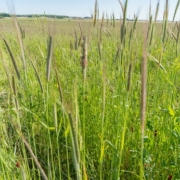Researchers Explore Cover Crop Viability as Biofuel
A team led by Washington State University scientists looked at four off-season cover crops to evaluate their biofuel potential and effect on the soil. The team published results of their study in the journal Biomass and Bioenergy. The study showed that triticale, a hybrid of wheat and rye, produced the highest yields, while hairy vetch provided stable yields at low costs and added nitrogen to the soil. The team also looked at biofuel potential for each cover crop utilizing hydrothermal liquefaction, which allows processors to mix different types of biomass to produce biofuel. The study showed that each crop included in the field trials can be processed into biofuels through the liquefaction process. In addition, the research team investigated whether removing the biomass from fields reduced the benefits normally derived from cover crops, and determined no soil harm from harvesting the triticale for biofuel production. “Cover crops have always been grown to help the soil, but now farmers may actually be able to get paid for them as well,” noted study co-author Chad Kruger. “Add that to the benefits of biofuels, and it’s a positive for everyone.”

 Indiana NRCS photos by Brandon O’Connor
Indiana NRCS photos by Brandon O’Connor Vermont Law & Graduate School
Vermont Law & Graduate School
